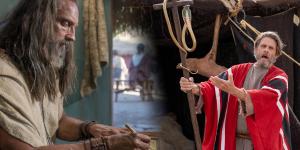You are here
Why Was Jesus Proclaimed the Son of God at His Baptism?

Mark 1:11; cf. Matthew 3:17; Luke 3:22
The Know
When Jesus was baptized at the beginning of His ministry, several divine manifestations confirmed to all present that He was “the Lamb of God, which taketh away the sin of the world” (John 1:29). These very meaningful manifestations included the opening of the heavens, the Holy Ghost descending upon Jesus, and the voice of the Father speaking from heaven.
Mark and Luke quote God as speaking directly to Jesus: “And there came a voice from heaven, saying, Thou art my beloved Son, in whom I am well pleased” (Mark 1:11, emphasis added; cf. Luke 3:22). Matthew records God speaking to the audience who witnessed Jesus’s baptism. In any royal investiture, words were naturally addressed both to the one being elevated to the throne and also to the people who then would honor that ruler as their divinely appointed leader.
All three of these Gospels, commonly referred to as the Synoptic Gospels, appear to be quoting or alluding to Psalm 2:7, which is often viewed as a prominent royal psalm associated with the coronation of ancient Israelite kings: “I will declare the decree: the Lord hath said unto me, Thou art my Son; this day have I begotten thee” (emphasis added).
In the ancient Near East, it was common for kings to be referred to as the son of a deity and for them to go through a ritual initiation process to receive power and authority to act in that god’s name.1 In this respect, kings were regarded as having divine qualities. Thus, as Jasmin Gimenez Rappleye has noted, “To be a son of God is, at its core, to inherit divinity and assume a form of deity. Proclamation of Jesus’s sonship is tacit confirmation of his godhood.”2
Matthew B. Brown has observed that the initiation of kings was tied directly to the temple precinct and involved the kings’ admission into the presence of God.3 It is significant that many elements of the Israelite temple then appear in Jesus’s baptism, when He initiated His ministry and the presence of all three members of the Godhead became manifest. For example, receiving a new name—specifically, the identity of the Son of God—is coupled with receiving the washing and anointing ordinances. The washing rite readily correlates with Jesus’s being immersed and therefore washed by water at His baptism.
As for the anointing, this occurred symbolically when the Holy Ghost came in “the form of a dove” and rested upon Jesus.4 In the Old Testament, Isaiah specifically connected the Spirit with anointing (Isaiah 61:1), and Peter would later tie this concept even more directly to Jesus’s experience in the Jordan: “God anointed Jesus of Nazareth with the Holy Ghost and with power” (Acts 10:38; emphasis added).5 Joseph Smith further connected the “sign of the dove” at Jesus’s baptism with the proper identification of angels—another temple-related theme.6
Finally, when Jesus came up out of the water at His baptism, it is noteworthy that the heavens were “torn open,” according to the literal Greek translation of Mark 1:10. At this rending or parting of the heavenly veil, Jesus was admitted into the presence of two members of the Godhead, He Himself being the third member incarnate. His baptism thus ultimately led to a type of divine confirmation or encounter, much like prophetic callings found in the Old Testament.7
The Why
The baptism of Jesus was the inauguration of Jesus’s ministry and salvific work. Jesus’s identity as God’s Only Begotten Son was confirmed in a dramatic manner as the veil between heaven and earth was rent and the presence of all three members of the Godhead became manifest. Such a monumental experience sets a precedent for each of us to follow. As Nephi expressed near the end of his life, “if the Lamb of God, he being holy, should have need to be baptized by water, to fulfil all righteousness, O then, how much more need have we, being unholy, to be baptized, yea, even by water!”8
Elder Bruce R. McConkie taught, “To fulfill all righteousness is to perform every ordinance, keep every commandment, and do every act necessary to the attainment of eternal life.”9 These ordinances, commandments, and acts include those performed in the holy temple, which are prefigured by the ordinance of baptism.
By making covenants with the Lord, we too can take upon us the name of the Son of God and follow the path Jesus set. Regarding our own journeys on this covenant path, Rappleye has observed, “Jesus Christ promises his followers that those who repent of their sins and embrace the gospel will have joint access to Jesus’s identity as a Son.”10 In other words, by following the example that Jesus set, all individuals can eventually approach the Lord and be admitted into His presence as covenantal sons and daughters of God.
Further Reading
Jasmin Giminez Rappleye, “The Messianic Sacred, Not Secret: The Son as a Hidden Name in the Gospel of Mark,” in The Temple: Past, Present, & Future: Proceedings of the Fifth Interpreter Matthew B. Brown Memorial Conference, “The Temple on Mount Zion,” 7 November 2020, ed. Stephen D. Ricks and Jeffrey M. Bradshaw (Orem, UT: Interpreter Foundation; Salt Lake City, UT: Eborn Books, 2021), 171–196.
John W. Welch, “Matthew 1–4,” in New Testament Minute: Matthew, ed. Taylor Halverson (Springville, UT: Scripture Central, 2023).
John S. Thompson and Jackson Abhau, “Mark 1,” in New Testament Minute: Mark, ed. John W. Welch (Springville, UT: Scripture Central, 2023).
S. Kent Brown, “Luke 3,” in New Testament Minute: Luke, ed. John W. Welch (Springville, UT: Scripture Central, 2023).
- 1. A biblical example of this can be found through Solomon, of whom the Lord declared, “I will be his father, and he shall be my son” (2 Samuel 7:14). For additional studies regarding the divine nature of kingship in the ancient Near East, see Nicole Brisch, ed., Religion and Power: Divine Kingship in the Ancient World and Beyond (Chicago, IL: Oriental Institute, University of Chicago, 2008).
- 2. Jasmin Gimenez Rappleye, “The Messianic Sacred, Not Secret: The Son as a Hidden Name in the Gospel of Mark,” in The Temple: Past, Present, and Future: Proceedings of the Fifth Interpreter Matthew B. Brown Memorial Conference, “The Temple on Mount Zion,” 7 November 2020, ed. Stephen D. Ricks and Jeffrey M. Bradshaw (Orem, UT: Interpreter Foundation; Salt Lake City, UT: Eborn Books, 2021), 181.
- 3. See Matthew B. Brown, “The Handclasp, the Temple, and the King,” in Temple Insights: Proceedings of the Interpreter Matthew B. Brown Memorial Conference, “The Temple on Mount Zion,” 22 September 2012, ed. William J. Hamblin and David Rolph Seely (Orem, UT: Interpreter Foundation; Salt Lake City: Eborn Books, 2014), 5–10; reprinted in Interpreter: A Journal of Latter-day Saint Faith and Scholarship 42 (2021): 421–426.
- 4. Baptism has long been understood as a symbol for death and resurrection, and the sign of the dove that was manifest at Jesus’s baptism may have had ties to “the sign of Jonah,” especially since the name Jonah means “dove.” See Book of Mormon Central, “What Is the Sign of Jonah? (Matthew 12:39–40),” KnoWhy 652 (November 23, 2022).
- 5. A pseudepigraphal text known as the Gospel of Philip also links Jesus’s baptism and receiving the Holy Ghost to a washing and anointing ordinance, although the text is fragmented: “Jesus appeared [. . .] Jordan, the fullness [of the] kingdom of heavens. The person who [was born] before all things was reborn; the one anointed in the beginning was reanointed.” The Gospel of Philip 70:34–71:3, in Bentley Layton and David Brakke, trans., The Gnostic Scriptures, 2nd ed. (New Haven, CT: Yale University Press, 2021), 486–487. John Tvedtnes noted that anointing with olive oil—another practice attested in early Jewish and Christian ordinances—could likewise be a symbol for the anointing of the Holy Ghost in early Christian thought. See John A. Tvedtnes, “Olive Oil: Symbol of the Holy Ghost,” in The Allegory of the Olive Tree: The Olive, the Bible, and Jacob 5, ed. Stephen D. Ricks and John W. Welch (Salt Lake City, UT: Deseret Book; Provo, UT: Foundation for Ancient Research and Mormon Studies, 1994), 447. This is discussed in more detail in Rappleye, “Messianic Sacred, Not Secret,” 185.
- 6. See, for example, Doctrine and Covenants 129; “Discourse, circa 21 March 1841, as Reported by Martha Jane Knowlton Coray,” p. [25], The Joseph Smith Papers. See also Rappleye, “Messianic Sacred, Not Secret,” 185–186, for a discussion on Joseph Smith’s teachings of the sign of the dove.
- 7. See Rappleye, “Messianic Sacred, Not Secret,” 183–185. See also Evidence Central, “Book of Mormon Evidence: Lehi’s Prophetic Calling (Divine Confrontation),” March 29, 2022.
- 8. 2 Nephi 31:5; see also 1 Nephi 10:9–10; 11:27–28. John W. Welch discusses the reasons Nephi gives for Jesus’s baptism as follows: “(1) He humbled himself before the Father; (2) He covenanted to be obedient and keep the Father’s commandments; (3) He had to be baptized to gain admission to the celestial kingdom; and (4) He set an example for all to follow (2 Nephi 31:4–11).” John W. Welch, “Matthew 1–4,” in New Testament Minute: Matthew, ed. Taylor Halverson (Springville, UT: Scripture Central, 2023), 15.
- 9. Bruce R. McConkie, Doctrinal New Testament Commentary, 3 vols. (Salt Lake City, UT: Deseret Book, 2002), 1:123.
- 10. Rappleye, “Messianic Sacred, Not Secret,” 183. See also Mosiah 5:7; Romans 8:16–17.
KnoWhy Citation
Related KnoWhys
Subscribe
Get the latest updates on Book of Mormon topics and research for free





